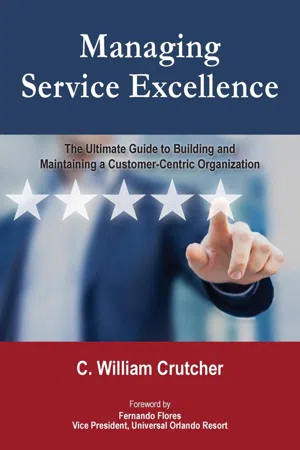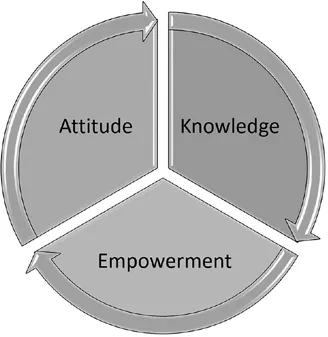![]()
CHAPTER 1
Foundations of Customer Service
Importance of Customers
Without customers, you do not have an enterprise. Obvious as this may seem, we don’t always behave in a mode of customer service excellence. Simply stated, customers are the reason you are in business. Yes, various stakeholders may rely on your business, including employees, stockholders, the community and others. But the primary and most essential stakeholder is your customer. Without their present and anticipated repeat business, your organization has little viability and no sustained purpose for being.
It is also important to understand that the customer is your source for improvement and innovation. When you seek and act upon customer feedback, you learn what you are doing well and what needs to improve. It may be advice that a process is cumbersome or inefficient, or it may be an idea for an entirely new product. Listening to your customer, through both formal (e.g., satisfaction surveys) and informal (e.g., ad hoc comments) feedback, will reveal what you need to do to keep them coming back. (In Chapter 9 we will address mechanisms for collecting customer input.)
Customer feedback can also drive the strategic direction of a business. What customers are buying and not buying should influence every organization’s decision-making. If you build it, they just may not come. Organizations that are responsive to changing customer wants and expectations will find that providing the same products and services they did just five years ago may not be effective in next year’s marketplace.
The bottom line is that businesses exist because of their customers. The wise businessperson knows that the customer makes tomorrow possible, and behaves accordingly every day.
A Customer-Centric Culture
All organizations have a primary culture. Larger organizations also have subcultures (e.g., divisions, departments) that, hopefully, support the primary culture. What is a culture? It is the combined behaviors of the employees—behaviors that are both encouraged (planned) and tolerated (not always positive). Cultures can be informal, i.e., undocumented and free-flowing. Employees “learn” such cultures through observation and enforcement or lack thereof. Organizations with clear expectations of employee behaviors, on the other hand, typically document organizational values and supporting behaviors. Employees are educated on these values to ensure they clearly understand how the values are to be reflected in day-to-day work activities. Leadership then reinforces those expectations through routine feedback in the form of goal setting, review and performance evaluation.
On my way one day to the university where I teach, I stopped at a fast-food restaurant for coffee. Waiting in line, I noticed a plaque on the wall that read, “Whatever it takes. We will do whatever it takes to satisfy our customers.” I thought it was a visible display of a strong customer-centric culture. When I reached the counter, I asked my order taker what that sign meant—hoping to hear something about an enterprise-wide focus on customers. Her reply was, “I’m not sure, they just hung it up the other day.” Organizational values with cultural expectations must include adequate training of all employees on those expectations if behavioral changes are desired.
The focus of an organization’s culture can contribute or detract from its overall success. Take for example the company that places client billable hours as the most important measure of overall organizational success. That culture carries the risk that customers, employees and other stakeholders will be shortchanged in the process—not getting what they need and deserve.
If you focus on making money, you will do the wrong thing.
If you focus on doing the right thing, you will make money.
—C. WILLIAM CRUTCHER
A customer-centric focus puts the customer first. This includes the “bill-paying” customer and the “internal” customer—the employees. The organization with a customer focus marshals its resources to not only provide the best products and services, but also to create relationships, assuring the customer they are the reason the company exists. Customers must be valued and never taken for granted. The remainder of this book provides essential practices for creating and maintaining a customer-centric organization.
LIVING A CULTURE OF SERVICE
How can we tell if an organization is “living” a culture of service? There are several associated indicators.
First and foremost, the culture is agile, resilient and principled. It is grounded in shared values that all employees embrace. Achieving and maintaining the desired culture requires that each employee understand the values and how they impact their day-to-day performance.
Leadership turns great strategy into great performance. This means that the organization’s mission, vision and values are shared with all employees. Creating “line-of-sight” to the mission, vision and values for all employees is key to sustaining the desired culture.
Promises are kept by all employees. While this sounds simple, one of the greatest sources of employee and customer dissatisfaction is unfulfilled promises. We get busy, overextend ourselves, forget to do something—whatever the reason, it sounds like excuses to the employee or customer. Keep the promises you make. Expectations must be met without excuses.
Every interaction is respectful and efficient—both internally and externally. How often do we give others a pass because they are having a bad day? What if everyone has a bad day? Is total chaos then acceptable? No. Regardless of personal issues, treating others with respect is an “always” condition. That is key to a true culture of service.
Last, we find that communication is clear, concise and consistent. We think about what we want to communicate before doing so. Whatever the nature of the communication, if the recipient doesn’t get understandable information, subsequent actions will fall short of expectations.
For example, suppose you ask your handyman to install a swing on your property. Upon arriving home that evening, you find a tire swing hanging from a tree limb in your backyard. But what you wanted was a porch swing. Absent clear information, the deliverable you get may be far different than the one you expect.
The Root of Service: Attitude, Knowledge and Empowerment
Excellence in customer service relies on key precursory conditions. First is an attitude of service. True customer service professionals understand that to effectively serve, they must put their own wants and needs behind those of the customer. That is not to say that the customer wins and the company loses, but that the customer is placed first. Imagine a large company parking lot at the close of day. There is chaos as employees struggle to be the next one out, cutting off others in the process. Now imagine if all employees had a “you first, then me” attitude. The picture is calmer and the lot empties more quickly. People go home happier. It is the same with effective customer service. When we employ a “you first, then me” approach to serving, we become better listeners, act more cordially and create relationships that lead to long-term customer loyalty.
A colleague and I went for a late lunch at a local chain restaurant. As we approached the register to place our order, we noticed the employee was focused on whatever she was doing on her cell phone. My colleague cleared his throat to get her attention. She looked up and exaggerated a sigh—her way of letting us know she did not appreciate being interrupted. The notion of an attitude of service was clearly not in her vocabulary, let alone her customer interactions.
The second root of service is knowledge. This means knowing your job and knowing it well. Know your products and services and what they can do for the customer. It is also important you understand how your job fits with others in the organization. Whether you are serving a steak, providing a technical report or delivering 10 yards of concrete, your customers rely on you to be the subject matter expert. You ARE the company and you determine the customer’s impression of your organization.
Have you ever been to a restaurant where your server appeared to not know their menu? While we should certainly appreciate the learning curve for new employees, it becomes frustrating when the server responds to every inquiry with “Let me check.” The server should take the time to learn what’s on the menu and what substitutions or modifications can be made. Lack of knowledge about your products or services does not instill confidence in your customers.
The third root of service is empowerment. It is frustrating for customers to deal with employees who are not able to resolve service issues. As the customer service professional, it is essential that you know what latitude you have to serve your customers. When there is a service breakdown, do you have to “check with the boss” or are you able to offer alternatives to the customer?
How goo...

